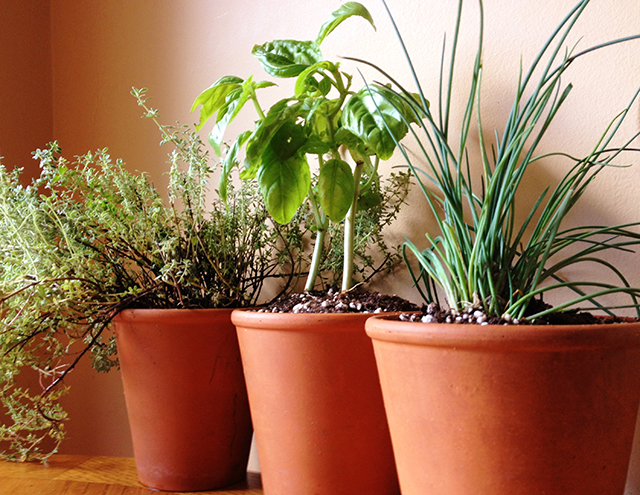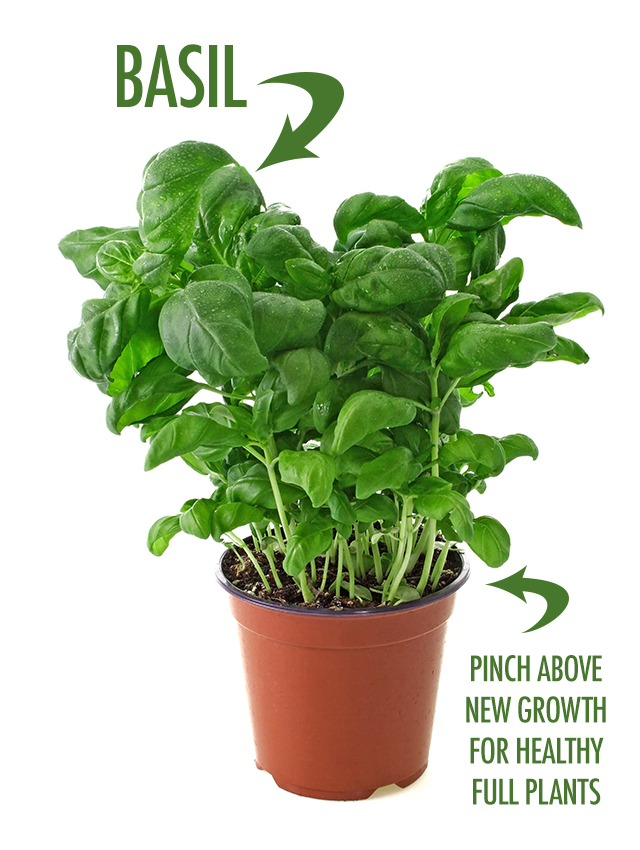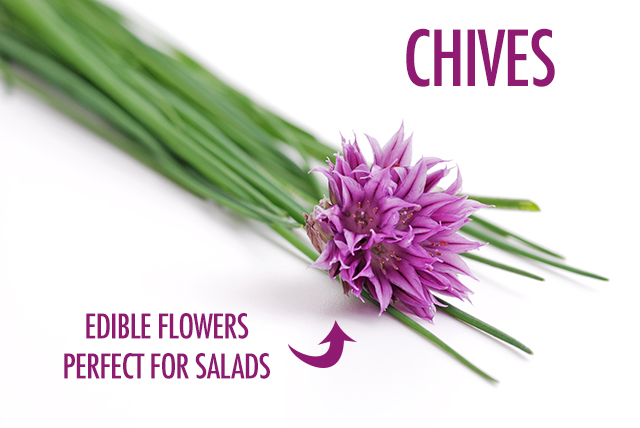Fall doesn't have to mean the end of enjoying fresh home grown herbs so we're sharing a list of our top five herbs to grow indoors this winter. We'll cover Basil, Chives, Oregano, Thyme and Rosemary, and share a how-to planting guide to get you started on an indoor herb garden with help from Gwen Wright.

The signs of autumn are spreading across Canada, and the annual harvest of fresh fall fruit and vegetables has begun. While it may sound a little odd to be thinking about planting at this time of year, now is the perfect time to plan an indoor herb garden to fill your kitchen with fresh ingredients all winter long.
Planning – pick your pots and pick your spots
Every home and apartment should have at least a few locations that will work for your herbs. Select windows and glass doors that allow for at least 4 hours of sun per day - afternoon sun is best. That being said, if you’ve only got a little light to work with, it’s just fine to use your sunniest spots and hope for the best, herbs are quite resilient.
Once you’ve decided where to grow your herbs, think about what pots and planters will work in that space – a line of small terracotta pots on a window sill, a few hanging baskets suspended from hooks in bright spaces or larger decorative pots on the floor by a patio or balcony door. You’ll also want to buy some herb-friendly, nutrient-rich potting soil to fill your pots.
Acquiring herbs – pick your favourite flavours and cuisines

The following list features five familiar herbs that grow well indoors and pair with a wide variety of cold-weather dishes. If you have different tastes, follow your palate to the herbs you’d like to see in your own cooking this winter – cilantro, sage, mint and tarragon can all lead to new experimentation with different cuisines.
You may choose to grow your indoor herbs from seed, from nursery-raised seedlings or from cuttings off outdoor plants. As it can be a bit tricky and time consuming to grow herbs from seed indoors in fall, try starting with nursery babies or outdoor garden transplants for your first indoor herb garden. The plants will be heartier and livelier (as you’ll be selecting the healthiest plants when you’re choosing) and you’ll be able to start harvesting earlier.
Harvesting Your Indoor Herbs
Once your herbs are settled in their pots and growing well, begin harvesting regularly and don’t hold back, the more you eat, the better your plants will grow. Nip off all flowers and buds from your herbs as soon as your spot them. This is your herbs trying to ‘bolt’, meaning they’re trying to create seeds and then go to sleep (no more delicious herbs to harvest). By snipping off all flowers, you encourage the herbs to continue producing all winter long.
Our Top Five Herbs To Grow Indoors This Winter
Basil

With basil, you’ll have a winter filled with Italian sauces, soups and pestos, as basil grows well indoors and can be picked regularly. To harvest clippings for your meals, pinch off bunches of large leaves with your fingers right above the new growth below, where you see two sets of new leaves growing. Each of these sets will send up new stalks and leaves, which you can pinch off the same way to create a bushy, full basil plant. Be sure to trim off any long, leaf-less stalks, as they can cause rot if left on the plants.
Use basil fresh as a garnish for pasta, pizza and sauces, in salad dressings or pureed into pesto.
Chives

Chives are a herb that many associate with spring, but they can be grown indoors all winter, and are actually quite decorative. To harvest, snip off bunches close to the base of the plant with scissors. If the chives stop producing new growth, put the pot in a dark closet for a few weeks, then bring it back to the sunny window and it should spring back to life. The purple flowers that chives produce are edible and delicious in salads, with a garlic-y flavour and crunchy texture.
Use chives in omelettes, salads, dressings, as a garnish over potatoes and cream-based soups, or baked into scones and savoury muffins. Here are 19 ways you can use chives in your recipes!
Oregano

Oregano is a very easy to grow herb that should produce all winter and be ready to plant in your garden next spring. To harvest, snip off entire stalks near the base of the plant, then strip off the leaves into your dishes.
Use oregano in your Italian sauces, to flavour roasts and stuffing, in Greek salads and lamb dishes.
Thyme

Thyme's tiny, flavour-packed leaves come in a ton of different varieties - select a cooking-friendly Thyme variety with a flavour profile you enjoy (spicy, lemony, etc.). Similar to oregano, snip off stalks near the base of the Thyme plant and strip the leaves into your dishes. Enjoy all winter, then plant in your garden next spring.
Use Thyme in all your chicken dishes, make thyme-scented oils and vinegars, and use fresh to garnish hearty beef stews and creamy fish chowders.
Rosemary

Rosemary, an aromatic and decorative herb, is great to have on hand during the holidays for a wide variety of festive dishes. To harvest, snip back stalks with scissors as desired. You can even get fancy and prune your Rosemary plant into a Christmas tree shape throughout the fall to create an edible holiday decoration ready for December.
Use rosemary in your winter roasts, to skewer lamb or flavour a stuffing. Rosemary also makes a nice hot drink, steep whole fresh stalks in hot water for a soothing winter tea that you grew in your own home. Here are 19 delicious ways you can use rosemary in your cooking.
Turn your own home into an indoor herb oasis this winter and you’ll be rewarded with fresh, flavourful ingredients for your cooking all the way until spring. Happy growing!

Gwen Wright is a freelance writer living on Vancouver Island, specializing in food and travel stories. A dedicated home cook and baker who grows her own year-round kitchen garden, Gwen is always seeking out new ways to use local and seasonal ingredients to create new dishes.
When she's not laptop-deep in a writing project, knee-deep in garden dirt or elbow-deep in bread dough, Gwen can be found hiking around Vancouver Island foraging for wild chanterelles, or covered in sand playing beach volleyball or paddleboarding on the shores of Parksville, British Columbia.
Connect with Gwen: Blog | Twitter | Facebook | Instagram | Pinterest
SaveSave








What about parsley? We’ve had one indoor for a few months and it’s growing steady. It also smells really good!
Perfect touch to add to pictures too.
These plants are a very good idea! Although I’m a professional gardener, I have no time for maintaining my own garden plus my rental is too small for making a balcony garden. I made a small herb garden in my kitchen and I water the plants and take care of them in the mornings, while drinking my coffee. It goes quite well and your post gave a me good idea for adding few new herb plants. Thank you for the information you’ve shared, it could be a good guide for people who haven’t tried planting till now. Greets, Molly from http://gardenerskingston.org.uk/ 🙂
My kitchen doesn’t get enough sunlight for herbs to do well, so I’ve set up a small grow room in my basement to grow herbs and veggies through the winter months. I’ve found cilantro to be another easy herb to grow indoors; just keep snipping it off before the seed pods develop and it will grow all winter.
Awesome tips. These are very useful for indoor growth, especially, indoor gardens. Save space, but very effective.
When I buy supermarket herbs in pots they die quickly. should i transplant into better soil?
That’s probably a good idea. Some, like rosemary and oregano, are tough little souls and will do well in most situations. But the basil pots you get at the supermarket need a little extra TLC if you want to keep them going inside for a long time. They’re not really potted to give them a long life – they’re more meant to give you a few extra days of life beyond buying cut basil!
I took have issues with the sun in our kitchen, or for that matter in the entire house during winter, just not enough light for growing anything. We set up a small 2×2 growtent and a small Grow Light. It did wonders last year and we are thinking of expanding to a larger tent to grow some tomatoes. We would like to grow Thyme as well, do you think it would be an issue growing the 2 together in the same tent? Thanks
I’ve heard conflicting reports about growing tomatoes and thyme together and have never tried it myself – mine are in completely areas of the garden from each other. But tomatoes and basil and tomatoes and chives do really well together. I’ve had good success companion planting with both of them – but I’ve never grown tomatoes indoors except as seedlings so you’ll have to experiment there for me 🙂 good luck!
Amazing tips here.
I was looking for some similar ideas to invest my spare time in. Gardening isn’t my everyday hobby, but i like to spend time in doing it. Thanks for the advice dear.